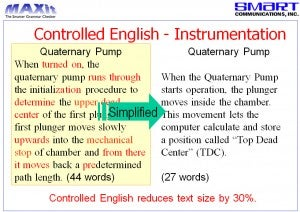Just a few words; improving Tech Comm Content via Simplified English
We recently had two webinars by Simplified English thought leader, John Smart of SMART SOFTWARE. John’s company has created several products that enhance FrameMaker by simplifying content and making it consistent. Here are some highlights of useful guidelines for achieving readable, “unambiguous” English that is only open to one interpretation, be it via translation or consumption by English consumers.
This blog’s insights were drawn from our recent recorded webinar with John Smart, “Going Global and Mobile with Adobe FrameMaker.”
The Challenge
Although the English language now has over 1,000,000 words, native speakers often use about 1,500 to 2,000 words per day. Unfortunately, these are 1,500 different words, so written content from two authors can be highly inconsistent.
Controlled English Defined
This is a simplified form of technical English based on 1,200 key words. This reduced vocabulary increases both usability and readability of English technical documentation. It is possible to express technical concept in clear, concise English without complex syntax or grammar.
Many Historic Precedents
One precursor to today’s Simplified English or Controlled English was Simplified Technical English (STE), developed in 1988 by Fokker Aircraft as ASD-STE100. Believe it or not, this formula was restricted to a total of 985 basic words:
- 512 Common Nouns
- 218 Verbs
- 36 Adjectives
- 20 Adverbs
- 18 Prepositions and Conjunctions
- 171 Technical Nouns
Controlled English makes content more readable
As the illustration below shows, use of Controlled English (through tools like MaxIt and competitive products that work with FrameMaker) can reduce text size by 30% and actually make the intent of the content much clearer.

Until about a year ago, ROI or benefits claims for Simplified or Controlled English have generally focused on improved language translation quality and reduced costs on such projects. Ironically, this reduced English vocabulary is also ideal for content destined for tablet computers and mobile devices.
Users of such devices are often consuming content “on their feet” and have to both find and comprehend technical messages more quickly. The types of Controlled English demonstrated in this recorded webinar can be ideal to achieve this goal. Best of all, many solutions like the one demonstrated by Mr. Smart work directly within FrameMaker, as authoring occurs.
Beyond Content Structure
A large number of blogs and webinars are still focusing on how content is structured or managed (e.g. DITA and CMS). These are significant issues for a successful tech comm solution, but we sometimes overlook something as basic as sentence structure. Since English is such a highly expressive language (1,000,000 words and growing daily), many of us need to retrain ourselves to compose content in a second, alternative way, with far fewer words.
I would predict that in the near future grammar schools, high schools and colleges will begin to include “global English” or “Simplified English” as part of basic curriculum. It would be simplistic to assume that by mid-Century all native-English speakers will transit over to universal vocabulary of about 1,200 words. But in order to communicate effectively with mobile English speakers and the rest of the world, we will have to adapt to this second way of communicating via text.